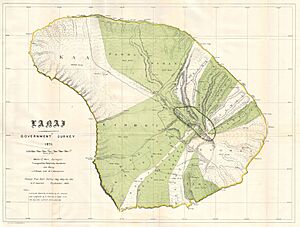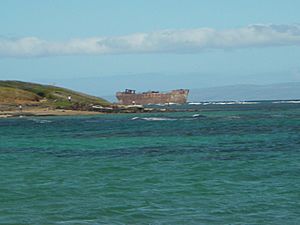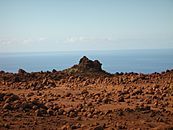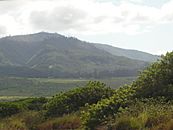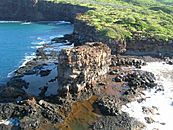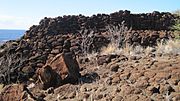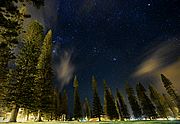Lanai facts for kids
|
Nickname: The Pineapple Isle
|
|
|---|---|

Landsat satellite image of Lanai
|
|

Location in the state of Hawaii
|
|
| Geography | |
| Location | North Pacific Ocean |
| Coordinates | 20°49′30″N 156°55′12″W / 20.82500°N 156.92000°W |
| Area | 140.5 sq mi (364 km2) |
| Area rank | 6th largest Hawaiian Island |
| Highest elevation | 3,366 ft (1,026 m) |
| Highest point | Lānaʻihale |
| Administration | |
|
United States
|
|
| State | Hawaiʻi |
| County | Maui County |
| Owner(s) | Larry Ellison 98% State of Hawaii 2% |
| Symbols | |
| Flower | Kaunaʻoa (Cuscuta sandwichiana) |
| Color | ʻĀlani (orange) |
| Largest settlement | Lanai City |
| Demographics | |
| Population | 3,367 (2020) |
| Pop. density | 23 /sq mi (8.9 /km2) |
| Ethnic groups | Hawaiian |
| Additional information | |
| Time zone | |
Lanai is the sixth-largest of the Hawaiian Islands. It is the smallest island in the chain that people can visit and live on. Many people call it the "Pineapple Island." This is because it used to be a giant pineapple farm.
The only main town on Lanai is Lanai City. Most of the island (98%) is owned by Larry Ellison. He is a co-founder of a big computer company called Oracle Corporation. The rest of the island belongs to the state of Hawaii or to people who own homes there.
Lanai is shaped a bit like an apostrophe. It is about 18 miles (29 km) long. The island covers about 140.5 square miles (364 km²). This makes it the 43rd largest island in the United States. Lanai is separated from Molokaʻi by the Kalohi Channel to the north. It is separated from Maui by the Auʻau Channel to the east.
In 2020, about 3,367 people lived on Lanai. Many places on the island can only be reached by dirt roads. You often need a four-wheel drive vehicle to explore them. This is because there are not many paved roads.
Lanai has one school, Lanai High and Elementary School. It teaches students from kindergarten all the way to 12th grade. There is also one hospital, Lanai Community Hospital. It has 24 beds. Lanai City also has a health center for doctors, dentists, and other care. You won't find any traffic lights on the island!
Contents
History of Lanai
Before written records, Lanai was controlled by the nearby island of Maui. The first people may have arrived on Lanai around the 1400s.
The Hawaiian name for the island is Lānaʻi. Its meaning is not fully known. But the island was often called Lānaʻi o Kauluāʻau. This means "day of the conquest of Kauluāʻau." This name comes from a legend. It tells of a prince from Maui named Kauluāʻau. He was sent to Lanai because he caused a lot of trouble. The island was said to have scary ghosts and goblins. Kauluāʻau chased them away. This brought peace to the island. It also helped him get back into his father's good graces.
The first people to live here likely came from Maui and Molokaʻi. They probably started fishing villages along the coast. Later, they moved inland. There, they grew taro in the rich volcanic soil. For a long time, the rulers of Maui controlled Lanai. But they usually left the people of Lanai alone.
However, at one point, King Kamehameha I or Kalaniōpuʻu attacked the island. Many people were killed. By 1792, the population was much smaller. Captain George Vancouver sailed past the island that year. He didn't stop because it looked like no one lived there. Lanai was said to be King Kamehameha's favorite fishing spot.
The first time sugar was grown in Hawaii was on Lanai. In 1802, a farmer from China, Wong Tse Chun, grew a small amount. He used a simple stone mill to crush the sugar cane.
In 1854, a group from the Church of Jesus Christ of Latter-day Saints leased some land on Lanai. In 1862, Walter M. Gibson came to organize their settlement. A year later, he bought the land for $3,000. He used church money but put the land in his own name. When the church members found out, they removed him from the church. But he still kept the land. By the 1870s, Gibson owned most of the island. He used it for ranching cattle.
By 1890, only about 200 people lived on Lanai. In 1899, Gibson's daughter and son-in-law started a sugar company. It was called Maunalei Sugar Company. It was located in Keomuku. The company failed in 1901. But between 1899 and 1901, almost 800 workers came to the island. Most were from Japan. Many Native Hawaiians continued to live along the coast. They made a living by ranching and fishing.
By 1907, Charles Gay, a cattle rancher, owned about half of the island. With help from sugar planter William G. Irwin, Gay worked to buy the rest of the land. A law called the Hawaiian Organic Act made it illegal for the government to sell so much land to one person. But they found a way around it. Gay traded land he owned in Honolulu for the rest of Lanai. This deal finished on April 10, 1907. Gay then borrowed $200,000 from Irwin, using the Lanai land as a guarantee. By 1909, Gay couldn't pay back the loan. So, he officially gave the land to Irwin. This led to a common myth that the land was bought for just $1. But the real cost included the $200,000 loan.
In 1921, Charles Gay planted the first pineapple plant on Lanai. The population had dropped again, to only 150 people. Most of them were from the island's original families. A year later, James Dole bought the island. He was the president of Hawaiian Pineapple Company (later Dole Food Company). He turned a large part of Lanai into the world's biggest pineapple farm.
When Hawaii became a state in 1959, Lanai became part of Maui County.
In 1985, David H. Murdock took control of Lanai. He bought Castle & Cooke, which owned Dole at the time. Growing pineapples in Hawaii became too expensive in the 1980s. So, Dole stopped its pineapple farms on Lanai in 1992.
In June 2012, Larry Ellison bought 98 percent of the island for $300 million. He was the CEO of Oracle Corporation. The state and private homeowners own the other 2 percent. This includes the harbor and homes where the 3,000 people live. Ellison said he wanted to spend $500 million to improve the island. He planned to make its farming more environmentally friendly. He spent about $450 million to update his Four Seasons Resort Lanai. It reopened in 2016. He also updated his other resort in 2020. He had plans for more green energy projects, but he has since ended that plan.
Ancient Legends of Lanai
According to Hawaiian legends, scary, man-eating spirits once lived on Lanai. For many years, the chiefs of Maui believed in these spirits. Different legends say that either the prophet Lanikāula or the mischievous Maui prince Kauluāʻau got rid of the spirits.
The most popular story is about Kauluāʻau. He was a prince who loved to pull up every breadfruit tree he found on Maui. His father, Kakaalaneo, had to send him away to Lanai. The king thought Kauluāʻau would not survive there. But Kauluāʻau was clever. He outsmarted the spirits and chased them off the island.
The chief on Maui saw his son's fire burning each night on Lanai. He sent a canoe to bring the prince back. Kauluāʻau had proven his bravery and cleverness. As a reward, his father gave him control of the island. He also encouraged people from other islands to move there. While on Lanai, Kauluāʻau had pulled up all the breadfruit trees there too. This is why there were not many breadfruit trees on the island for a long time.
Geography of Lanai
The highest point on Lanai is Mount Lānaʻihale. It is an inactive volcano near the center of the island. It is east of Lanai City. Mount Lānaʻihale is 3,366 feet (1,026 m) tall.
Lanai was traditionally divided into 13 political areas. These were called Ahupuaʻa. They were grouped into two main districts: kona (meaning leeward) and koʻolau (meaning windward).
| Nr. | Ahupuaa | Area acres |
Area km2 |
Population |
|---|---|---|---|---|
| 1 | Kaa | 19468 | 78.78 | 207 |
| 2 | Paomai | 9078 | 36.74 | 147 |
| 3 | Mahana | 7973 | 32.27 | 1 |
| 4 | Maunalei | 3794 | 15.35 | 0 |
| 5 | Kalulu | 6078 | 24.60 | 1 |
| 6 | Kaunolu | 7860 | 31.81 | 3 |
| 7 | Palawai | 5897 | 23.86 | 1 |
| 8 | Pawili | 1930 | 7.81 | 0 |
| 9 | Kaohai | 9677 | 39.16 | 1 |
| 10 | Kamao | 2751 | 11.13 | 2 |
| 11 | Kealia Aupuni | 5897 | 23.86 | 2 |
| 12 | Kealia Kapu | 1829 | 7.40 | 1 |
| 13 | Kamoku | 8291 | 33.55 | 2804 |
| Lanai | 90523 | 366.33 | 3170 |
Most people on Lanai live in the Kamoku area. This is because a large part of Lanai City is there. Some parts of Lanai City also reach into Kaa and Paomai. In 2010, most of the other ahupuaʻa had almost no people living in them. Lanai City has about 99 percent of the island's population.
About 100,000 years ago, a volcano on Lanai collapsed. This caused a huge megatsunami. It flooded land that was over 984 feet (300 m) high.
Tourism and Fun on Lanai
Tourism on Lanai became popular more recently. This happened after the pineapple and sugarcane farms closed down. Not many visitors come to the island compared to other Hawaiian islands. In 2016, about 59,000 visitors were expected. Only Molokaʻi gets fewer visitors.
As of 2016, two resort hotels on Lanai were run by Four Seasons Hotels. One is the Four Seasons Resort Lanai at Manele Bay. The Hotel Lanai in Lanai City was built in 1923. James Dole built it for his pineapple company. It was a place for company leaders to stay. It was the only hotel on the island until 1990.
Lanai also has three golf courses. Two are at the Four Seasons resorts. The third one is free to play.
- The Challenge at Manele is next to the ocean. It was designed by Jack Nicklaus. Bill Gates got married on the 12th hole of this course.
- The Experience at Koele is in the mountains of Lanai. It was designed by Ted Robinson Sr. Greg Norman also helped with the design.
- The Cavendish is a public golf course. It was designed by E.B. Cavendish in 1947. It has nine holes and is surrounded by Norfolk pine trees.
Shipwreck Beach is on the north shore of the island. It gets its name from a wrecked ship close to the shore. People often call it a World War II Liberty Ship. But it is actually a concrete barge called YOG-42.
Getting Around Lanai
In Lanai City, there are no traffic lights and no shopping malls. The hotels provide transportation for guests. Most places outside the hotels and town can only be reached by dirt roads. You will need an off-road vehicle, a bicycle, or you can walk.
Lanai is served by Lanai Airport. You can find air taxis and regular flights to other Hawaiian islands there.
Famous People from Lanai
- Danny Lockin: He was an actor and dancer. He was born in Lanai in 1943. He is best known for playing Barnaby Tucker in the 1969 movie Hello, Dolly!. He also played this role in the Broadway play's tour.
Gallery
-
Walls of Halulu Heiau at Kaunolu Village Site
See also
 In Spanish: Lanai para niños
In Spanish: Lanai para niños


